Are you in the market for a ductless type of air conditioner? If so, then you should consider window or through the wall models; but which will suit your needs?
In this article, we take an in-depth look at these two types of air conditioning units. We examine their strengths and weaknesses to help you make the right choice for your installation. With this information at your fingertips, you can make an informed decision on what is right for you, saving you time and money.
To start, we take a quick peek at some pros and cons of the two models.
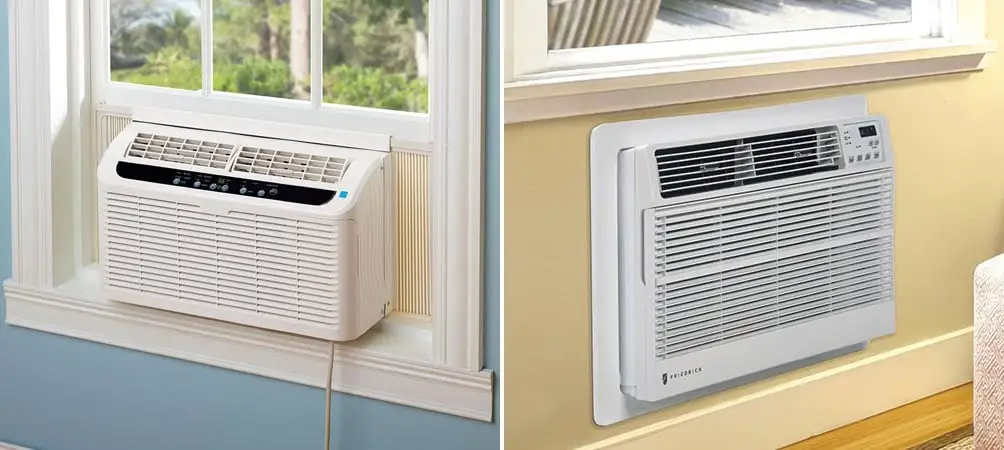
Through the Wall vs Window Air Conditioner

Through the Wall Air Conditioner
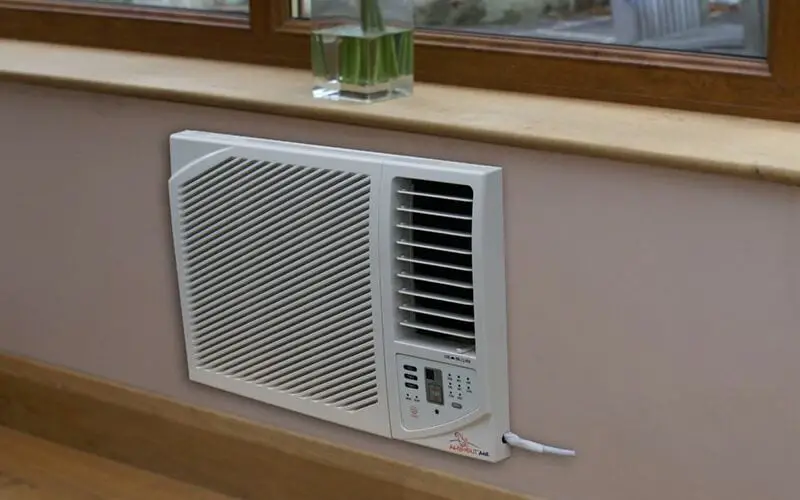
Window Air Conditioner
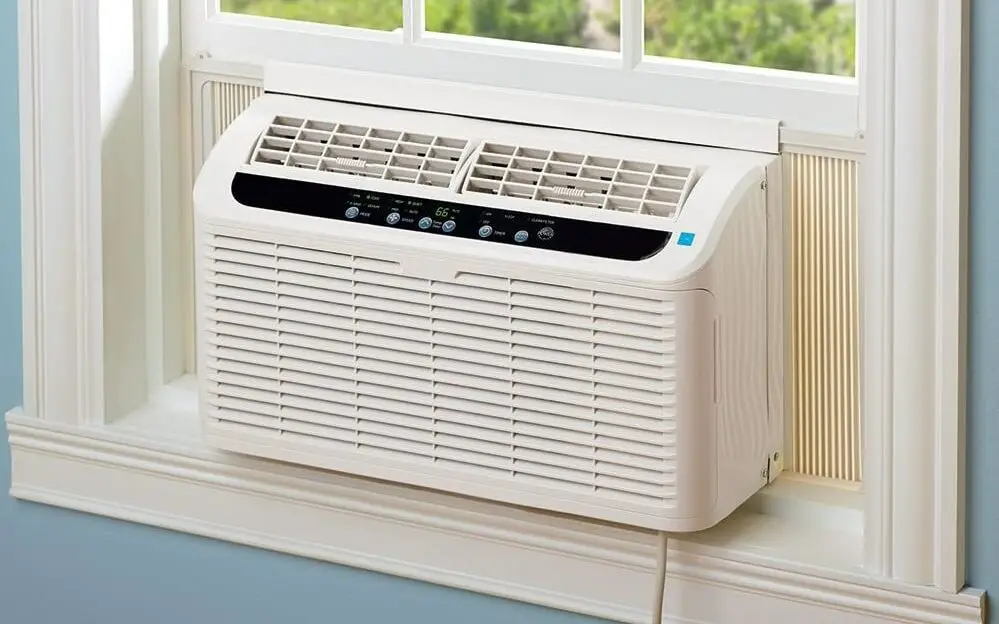
Pros
Through the Wall Air Conditioner
Your view through your windows is not obscured
Very secure compared to a window air conditioner
Fits tightly to the wall and is easy to seal, so it’s airtight
Permanently installed, so there’s no need to move the unit
Runs more quietly as the wall provides some insulation from the noise
Window Air Conditioner
DIY fitment is simple
Very affordable units
No construction is required
Convenient and very easy to install
Cons
Through the Wall Air Conditioner
Not as many models are available
The units tend to be more expensive
Higher installation costs, in the area of $300 to $600
Sleeves are required, which will cost around $70 to $115 more
They are more difficult to remove, and there will be construction costs to repair the hole
Cost of supplying electricity to the unit. This can be anywhere from $200 to $400 for the ground floor but considerably more if the unit is installed on a higher floor.
Window Air Conditioner
Can be noisy
Blocks the view from your windows
Does not seal as efficiently as wall units
It can be a security risk as it’s easy to remove
Curtains can’t be drawn, leading to sun damage on soft furnishings
What is a Through the Wall Air Conditioner?
A through-the-wall air conditioner is exactly what its name implies. This is a self-contained unit that sits in a sleeve fitted in a hole in your wall. It will take warm air and humidity from the room and vent it to the outside. These air conditioners have louvers cut into the rear or the sides and the rear of the casing. These vents are used to bring fresh air into the unit, where it’s passed over the cooling elements and then blown into the room.
These units are suited to all domestic and small industrial and commercial applications. They are energy-efficient, cost-efficient, aesthetically pleasing, and very easy to operate.
How Do Wall Mounted Air Conditioners Work?
Wall-mounted air conditioners have the air handling unit attached to the wall inside the room. This unit contains the evaporator, a fan, and various electronic components. The air handler is usually housed in an attractive cover that fits the decor in the room. The air handler is typically mounted high on the wall. This way, the cool air is blown into the room, causing a disturbance in the air and leading to superior cooling.
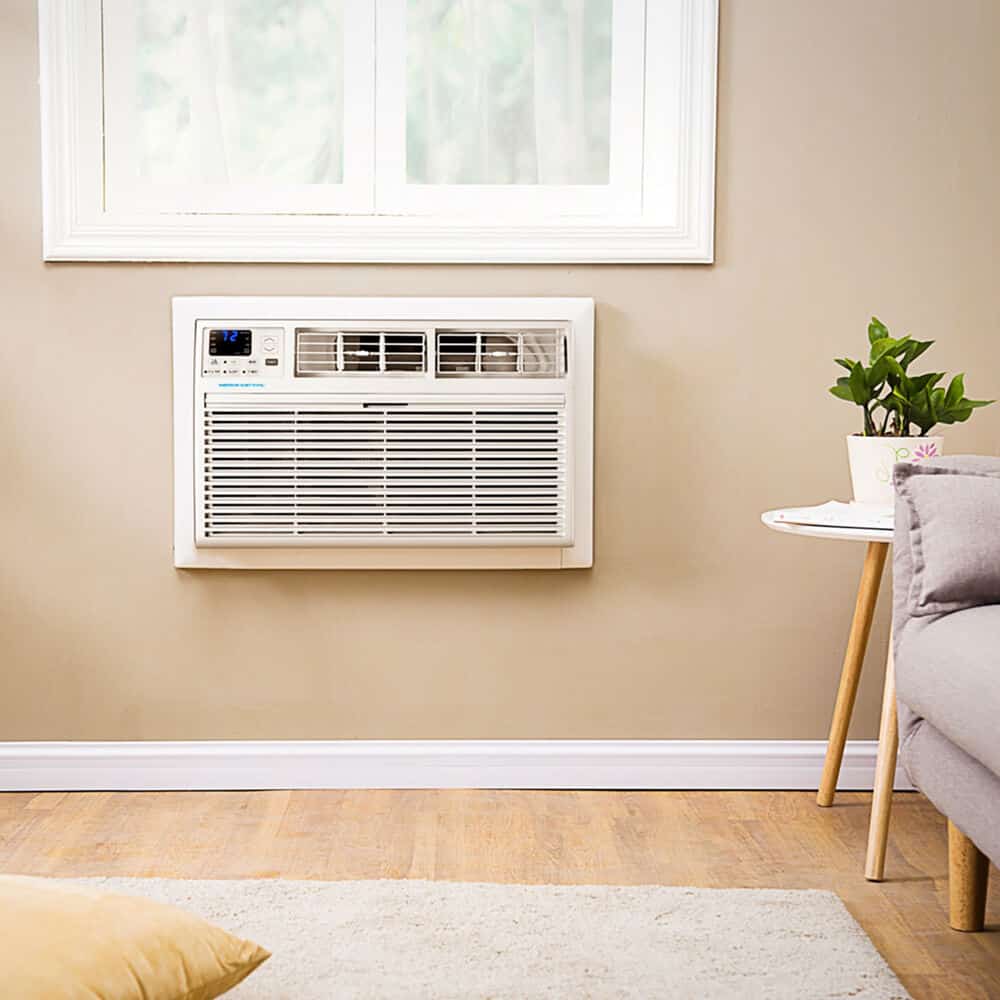
The evaporator unit will be housed outside the house. This will house the compressor, motor, electronics, and condenser tubes. This unit will be covered with a metal shroud that will have vents cut into it to facilitate good airflow.
As the refrigerant liquid is pumped through copper pipes into the air handler, warm air from the room is drawn over the evaporator tubes. The refrigerant liquid in the pipes absorbs the heat from the air, and at the same time, moisture condenses on the tubes.
As the refrigerant absorbs heat, it’s transformed into a gas and passed outside to the condenser. Here it’s condensed and pushed into the evaporator coils, which slowly release the heat to the outside environment. As this happens, the refrigerant gas gradually condenses back into a liquid. This cycle continues so long as the air conditioner is turned on.
What is a Window Air Conditioner?
A Window Air Conditioner is an all-in-one unit most often mounted in the window of a room. Because it’s a self-contained unit, there is no separate condenser unit. It’s the simplest form of air conditioning that can be installed.
This type of air conditioner can only be used to cool the room in which it’s installed. They’re suited to domestic and small commercial properties. This type of unit is usually inexpensive and can be fitted by a home handyman because there are no pipes to consider.
How Does the Window AC Work?
This self-contained unit exhausts humidity and warm air to the outside. The evaporator fan will drag air from the room through a filter and over evaporator coils. This air is then cooled and sent back into the room. At the same time, moisture condensing on the tubes will be discharged outside.

The gas inside the evaporator coils will be passed on to the condenser at the unit’s rear. In the condenser, it’ll be compressed and pumped into the condenser coils, where it’s cooled by fresh air being drawn in via vents in the case. The gas gradually condenses back into a liquid, where it’s passed back to the evaporator. Vents on the unit’s sides are also used to bring in air from the outside if the user wants fresh air instead of cooled air.
Relevant Characteristics Between Through the Wall and Window Air Conditioners
Through the Wall vs Window Air Conditioner
Compare by tapping or clicking below!

Cooling Capacity
Through the Wall Air Conditioner
Range from approximately 8,000 to 23,000 British Thermal Units (BTU)
Window Air Conditioner
Range from approximately 5,000 to 18,000 BTU
Coverage Area
Through the Wall Air Conditioner
20 BTU for each square foot of space to be cooled
Window Air Conditioner
20 BTU for each square foot of space to be cooled
Space Consumption
Through the Wall Air Conditioner
∓ 25” – 27” width
∓ 14”- 16” high
∓ 15” to 23” deep
Window Air Conditioner
Unit sizes range from 23” to 48” wide
Height from 14.5” to 20”
Installation
Through the Wall Air Conditioner
Requires minor construction to fit the sleeve to the wall
Window Air Conditioner
Can be fitted by a home handyman as no construction is required
Venting
Through the Wall Air Conditioner
Vent through the rear and sides
Window Air Conditioner
Vent through the rear and sides
Durability
Through the Wall Air Conditioner
Lifespan is ∓ 10 years
Window Air Conditioner
Lifespan is ∓ 10 years
Cost and Efficiency
Through the Wall Air Conditioner
$300 – $950
1100 – 2200 watts/hr
Window Air Conditioner
$150 – $300
1100 – 1700 watts/hr
Similarities and Differences
Now that we understand a little about these two types of air conditioners, let’s move on to digging a little deeper into the differences between them. These differences are significant when trying to decide which is the best type for your needs.
Wall and Window Air Conditioner Differences
The wall-mounted unit is more aesthetically pleasing because it doesn’t impede your view out of the windows. The window unit, as its name implies, is mounted in a window. This restricts the places that you can install it. With a through-the-wall type, you need only select an exterior wall, and the unit can be fitted anywhere on that wall.
The units themselves are not unattractive, but they take up space in windows. They’re also often at head height when sitting. It can be uncomfortable if the stream of chilled air hits you when you’re seated. Also, curtains can’t be drawn against the sun. In areas with strong sunlight, this can lead to fading on soft furnishings.
The window unit requires no construction work to fit and can be purchased and fitted by a home handyman. These DIY units are relatively simple to install, but creating an airtight seal around the unit is not always easy. Installation of a wall-mounted unit will require some construction, as a hole needs to be cut in the wall, the sleeve fitted, and then the unit is slid into the sleeve. Ensuring that there is an airtight seal is a simple process.
Through-the-wall units are also more secure. It’s not difficult to remove a window unit, but a wall unit is fixed in place and not easy to remove.
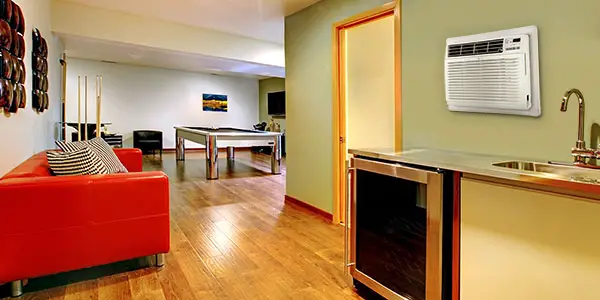
Wall and Window Air Conditioner Similarities
The most obvious similarity is that these two types of units both accomplish the same thing: cooling and dehumidifying the air in the room. Since they do the same job, it’s unsurprising that they both have the same components.
Both types of air conditioners will work in small to medium-sized environments. At the lower end of the range, they have the same BTU capacity and both work well to cool and dehumidify the air.
The calculation for the size air conditioner you wish to install will not change irrespective of the type of unit you choose to purchase. You can work on roughly 20 BTUs for each square foot of room. This number will be affected by factors such as windows, other equipment in the room, and the number of people in the room. So, do your research before making a final decision on the size.
Another glaring similarity is the durability of the product. Whether you purchase a wall unit or a window unit, you can expect the same life span from the air conditioners. Energy consumption is also similar in both types of units.
Are Wall and Window Air Conditioners Interchangeable?
Customers frequently ask if these two types of air conditioners are interchangeable. Can you fit a window air conditioner in the wall, or conversely, can you fit a wall air conditioner into a window?
Let’s deal with each case separately and examine whether it’s possible to fit a window air conditioner into the wall.
The answer to this question is yes, it’s possible to fit a window air conditioner into the wall. Below are some tips you should keep in mind:

Check the Wall
To fit this unit, you’ll have to cut a hole in the wall that matches the size of the unit you intend to fit. Make sure that you carefully check the position on the wall where you intend to make the hole to ensure that there are no electrical conduits or plumbing pipes in the area you will remove. Measure the casing accurately and arrange to have the required block removed from the wall. Remember that if you want to remove the air conditioner at a later stage, you’ll have this hole to refill.
Make Sure it’s an Exterior Wall
Your air conditioner will need to vent to the outside, so ensure that the wall you choose is an outer wall. Also, confirm that the wall will be able to carry the weight of the unit.
Electrical
Your air conditioner will require electricity to run, so make sure that you can supply the required current to the unit. This type of unit will usually run happily on a standard plug outlet. Most manufacturers won’t recommend that you extend the length of the cord supplied with the unit. Check the distance and make sure it’ll plug in to your closest outlet.
- Before you buy the unit, check to see if it has to vent out of the sides. If the unit vents out of the sides, ensure that you purchase the correct casing for the unit because it’ll have to slide out to work efficiently.
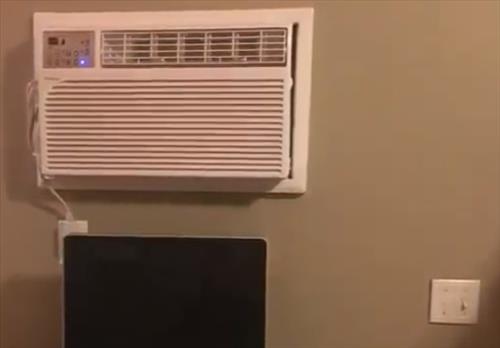
Now to answer the question of if a wall air conditioner can be fitted into a window. Here the answer is quite simple; no. Through-the-wall air conditioners fit specific sleeves designed to fit inside a wall and not in a window space.
There’s no infrastructure supplied to seal the opening, so creating an air-tight seal will be very difficult. The unit’s weight is designed to be supported by the wall, not a window frame, so it’s not advisable to fit a wall air conditioner into a window space.
Advantages of Through the Wall Air Conditioners
These air conditioners are inexpensive to purchase and install. The cost of the minor construction of cutting a hole and installing the sleeving is minimal compared to the installation of ducting or the purchase of a split unit.
Another benefit of this type of air conditioner is managing the temperature in single rooms selectively. Installing air conditioning throughout the entire house will set you back several thousand dollars upfront.
Using through the wall air conditioners, you can selectively manage the temperature in the most commonly used rooms. Because these air conditioners are adequately sealed into the wall, it’s unnecessary to pack them away when cold weather comes.
This type of air conditioner is extremely energy efficient, especially for small and medium-size rooms. Look for the Energy Guide Label that each air conditioner carries, and find the Energy Efficiency Ratio (EER).
Look for a model with an EER of 9.7 or higher as these are the most energy-efficient ones you can buy. If you think that this unit will be used often, then a high EER will save you money in the long run.

Many models of this type have various additional features:
- They’ll manage your room temperature all year round as they not only cool the air but warm it as well.
- They have a fan-only function to draw fresh air into the room.
- They have a sleep mode that’ll run quietly so as not to disturb your rest.
- They have louvers that can be adjusted to blow air where you want or to swing and distribute the cool air.
- They come with convenient digital controls and can be operated remotely.
Advantages of Window Air Conditioners
Window air conditioners are a perfect solution for people who don’t own the property in which they live. These units can be fitted to almost any type of window and are simple to pack up and take with you when you leave.
This is the cheapest type of air conditioner available on the market, so it’s a perfect choice for the cash-strapped consumer. As people become more conscious of living in smaller spaces, air conditioning units that are both energy efficient and tailor-made for small rooms will be trendy. This is where the window unit will come into its own because it’ll meet both these criteria.
Modern window air conditioners bear little resemblance to those manufactured years ago. They aren’t the noisy, rattly things that we see in the movies. The contemporary window unit is sleek, has better sealing capability, and comes with many features such as remote control, heating, cooling, fan only, and a 24-hour timer.
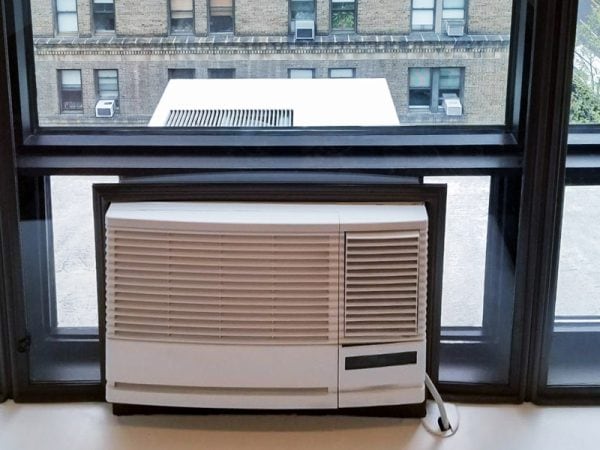
What About Mini Split Air Conditioners?
Ductless or mini-split air conditioners are a viable alternative to the homeowner. Essentially, they fulfill the same function as the window or through-the-wall units, but they have their components split. Inside is an air handling unit that contains the evaporator, fans, and electronics.
Outside you find a metal casing that includes the compressor, motors, cooling apparatus, and fans. The air handling unit is usually mounted high on a wall, almost at ceiling height, and copper pipes are passed through the wall to connect the two pieces and facilitate the refrigerant’s movement.
Window and through-the-wall units are generally mounted low, which can be an issue if the air is blown at you at head height. Mini-split units discharge their air high in the room, thus cooling the entire space without blowing directly on you.
Installation of a mini-split unit is simple in comparison to a wall unit. The mini-split unit requires only a couple of small holes to be drilled through the wall to carry the pipes, rather than a large hole to hold the entire unit.
This mini-split unit is the most secure of all the options as there is nowhere for a criminal to try and gain access. This is an issue with window-mounted units and less so with through-the-wall units, but the fact remains that there’s a large hole in the wall with a through-the-wall unit.
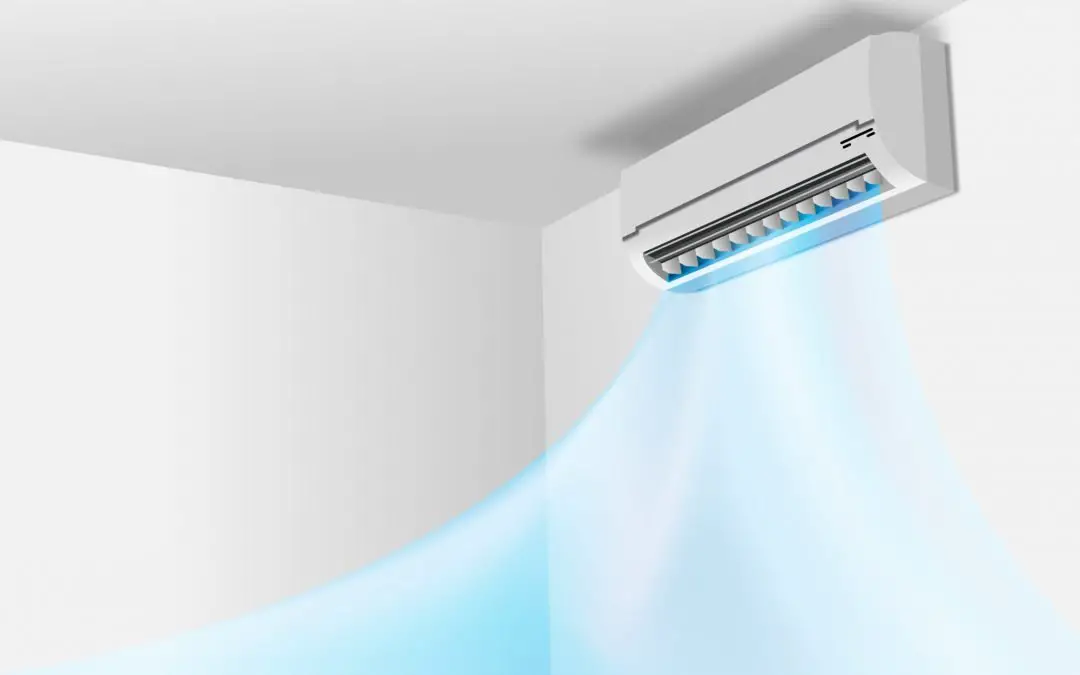
Aesthetically, these units are perhaps the most pleasing to the eye as they aren’t immediately apparent in a room. They are mounted high on a wall above eye height, and the air handling units are usually sleek in design and very attractive.
When and Why Would I Use a Through the Wall Air Conditioner?
If you’re wondering when to use this AC type, have a look at the following factors first.
Cooling and Heating at a Low Cost
Installing a through-the-wall air conditioner makes a great deal of sense if you target a specific room. The installation cost pales in comparison to the costs of installing a ducted system and running that system to cool rooms that you don’t use.
By establishing systems in specific areas, you get the best of all worlds. A comfortable living temperature where needed and no wasted energy consumption in unused rooms. The unit only runs when you’re in the room.
Energy Efficiency
These air conditioners are some of the most energy-efficient ones that you can buy. As we have already said, the ability to cool or warm the rooms that need it is a great asset, and your wallet will thank you for it.
These air conditioners have excellent energy efficiency ratios, and looking for one that’s higher than nine will save you a considerable amount. Also, check the label for the Energy Star logo, so you can be sure that you are being energy efficient, saving money, and protecting the environment at the same time.
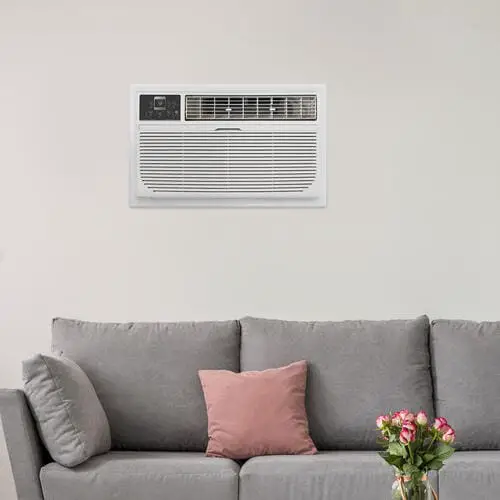
Space-saving, Secure, and Good Looking
Having your air conditioner mounted in the wall and not taking up window space is a great benefit. This also means that the window is free for fresh air on those lovely days. You can pull the curtains closed on hot days to help with managing the interior room temperature, not to mention saving your soft furnishings.
This type of wall-mounted air conditioner can’t be pushed out, unlike window air conditioners that do pose a security risk, especially for ground floor installations.
Not only will your windows be free, but having the unit mounted on the wall instead of freestanding saves a lot of space. This makes this type of air conditioner perfect for small apartments, small offices, or any other small commercial area.
When and Why Would I Use a Window Air Conditioner?
If you want to use a standard window air conditioner, here are some factors to consider.
Low Cost
Perhaps the most significant benefit of buying a window air conditioner is the cost. They’re inexpensive to purchase, with the average price being around the $300 mark. The final cost will depend upon the size of the unit you want to buy, along with the brand and additional features, such as remote operation or heating, as well as cooling.
Not only will they not slaughter your wallet when purchasing, but they’re also energy-efficient and won’t destroy your monthly budget.
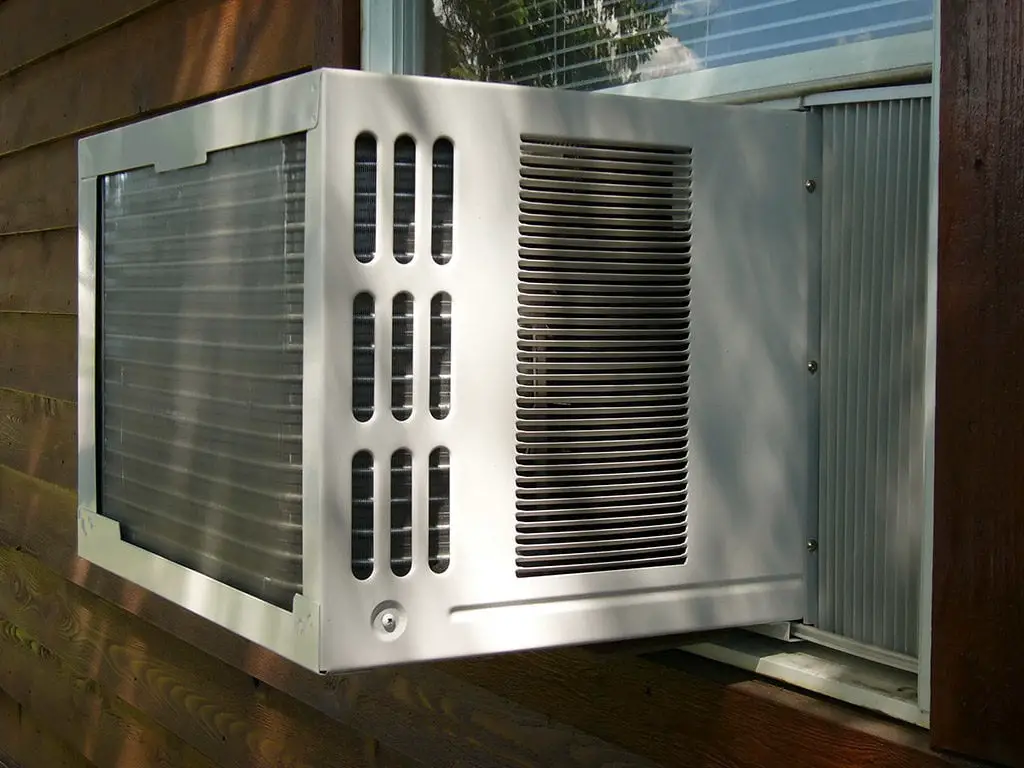
Ease of Installation
This is the most straightforward air conditioner to install. There’s no requirement for any construction work. The home handyman or woman is quite capable of installing this unit.
All the instructions and parts required to install the unit are included in the box. While it requires a little more than plug-and-play, almost anyone can install it.
Doing it yourself saves you from paying labor charges for a professional air conditioning service.
Portable (to a Point) and Versatile
This is the most straightforward air conditioner to install. There’s no requirement for any construction work. The home handyman or woman is quite capable of installing this unit.
While I would hesitate to say that this unit is portable, it can certainly be taken out at the end of summer and stored safely until the hot weather returns. Also, for those that are renting, it’s a simple matter to pack it up and take it with you when you move.
There’s no need to ask your new landlord to consider installing air conditioning because you have your own. It’s easy to move this type of air conditioner, making it very suitable for college rooms, apartments, offices, and small commercial enterprises.
Bottom Line
So what would you choose? The window air conditioner is uncomplicated, inexpensive, easy to use, painless to install, and simple to move. This would suit anyone renting a property, parents trying to make college accommodations a bit more comfortable, or the person that doesn’t have a great deal to spend but would like some cooling in the hot summer months.
The wall type air conditioner is more suited to a permanent installation. Still, it’s possible to move the unit and repair the hole in the wall. These are relatively inexpensive, don’t require significant construction to fit, are more secure, and very energy efficient.
They’re attractive units that take up no floor space but provide excellent cooling and heating. This type of air conditioner would suit any environment, and with a wide price range, there’s sure to be something that would suit most pockets.

People Also Ask
Many folks find the subject of air conditioning a little confusing and aren’t sure what would suit their environment. To help you, we have answered a few of the most common questions that we receive.
The best thing would be to consult the manufacturer’s instructions. In most cases, it’s preferable to install a sleeve (sold separately) to ensure a good fit and that the unit is sealed correctly. It also makes replacing the unit with a new one much more straightforward.
Sleeve sizes vary from approximately 15” high by 25” wide and from 16” to 23” deep. Again, consult the manufacturer’s recommendation for the size you need.
Yes, there are window air conditioners that provide heating as well as cooling. These tend to be at the higher end of the price scale, but they’re available. It’s unlikely that this type of heating would be sufficient in extreme cold.
Yes, this can be done but check your window air conditioner’s venting requirements first. If it vents out the sides and the rear, fitting it into an enclosed space will cause operational problems.
Not necessarily. Suppose a window air conditioner is correctly sized and correctly fitted. In that case, the adjustable window extensions will neatly fit in the gap between the side of the air conditioner and the edge of the window. These concertina-like extensions will fill the gap, preventing air from coming in.
